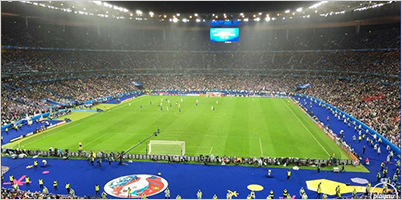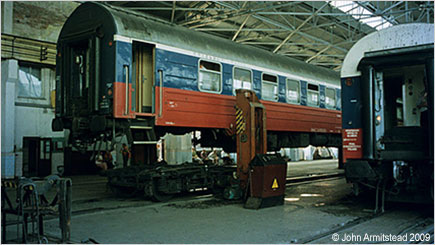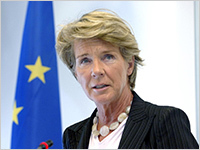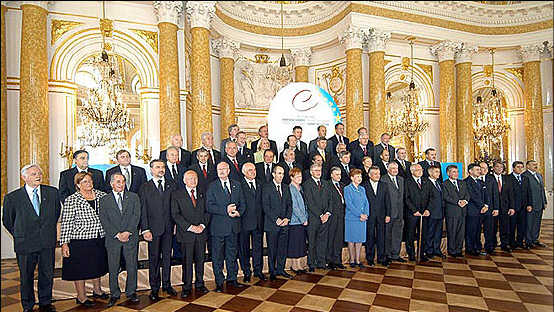Asset Publisher

Blood and honey
Serbia – 2006-2007
Denis HUBER

Belgrade, 21 September 2007. A large and cheerful crowd is rushing towards Nikola Pašić square, in the heart of the city. Traffic has been blocked, which inevitably leads to a concerto of car horns, but the atmosphere is festive: there are children everywhere, the late summer sun brings a touch of light and warmth. All eyes are on the platform erected in front of the Serbian Parliament, looking onto a huge blue flag with 12 gold stars, surrounded by four rows of silent children giving their full attention. There is thunderous applause when the 40 children (10 French, 10 German, 10 Russian and 10 Serb, dressed respectively in blue, white, red and purple) lift the gigantic flag which covers the whole area in front of this historic location, giving it a European splendour unimaginable a few years previously.
Standing on the platform, I am overwhelmed as I look at the scene, not only because my two sons are among the children waving the flag to the rhythm of the Serbian and European anthems. The Secretary General of the Council of Europe, Terry Davis is next to me with Oliver Dulić, the Speaker of the Serbian Parliament and the Minister of Culture, Vojislav Brajović. He stresses that “Serbia is, geographically, culturally, historically and politically, an integral part of Europe”, adding that “the flag which is hoisted today is our common flag”. The Serbian national anthem sung by Marija Šerifović, still revelling in her recent success at the Eurovision Song Contest, is taken up in unison by hundreds of voices. In response, the children enthusiastically sing the European anthem… in five languages (the English version, which brought everyone together, was sung at the end)!
I am proud to have initiated this event which was widely covered by the media and symbolised the new European and democratic foothold of a country ravaged by the tragedies of the 20th century. While congratulating my team at the Council of Europe Office in Belgrade, images from the previous 12 months flash through my mind, pirouetting like the movements of a symphony.
Allegro
12 September 2006. A little after 9 p.m. We are spending, a warm late summer evening en famille in our house in Reichstett, near Strasbourg. My mobile rings in the pocket of my shorts: it is Terry Davis, the Secretary General of the Council of Europe. He tells me that he has decided to appoint me as Special Representative in Serbia and Director of the Council of Europe Office in Belgrade. I thank him for this decision which does me a great honour and he replies that I am welcome, that he is convinced that he had chosen the best candidate for the post. He wishes me good luck and expresses his trust in me. Our life changes dramatically. We bring out the champagne.
The news is made official the following morning, in the Secretary General’s communication to the Committee of Ministers. After 10 years spent in that meeting room where the decisions that shape the present and the future of the Council of Europe are taken, I am happy to be able to have some field experience, to see whether (or not) our work in Strasbourg has a real impact in a very special member state: Serbia, which had joined the Organisation three years earlier after a very turbulent history, and which, in one year’s time, would be taking over the rotating chairmanship of the Committee of Ministers.
Although I had never set foot there, the country would not be unfamiliar to me. After having helplessly watched, from Strasbourg, the flood of violence between 1991 and 1995, the Council of Europe had played a leading role in reintegrating the former belligerents into the European family, by welcoming in turn Croatia (in November 1996), Bosnia and Herzegovina (in April 2002) and finally the Federal Republic of Yugoslavia which became the State Union of Serbia and Montenegro (in April 2003). This last accession had been particularly difficult due to the reluctance of Slobodan Milošević’s successors – starting with the man who toppled him in October 2000, Vojislav Koštunica – to make a clean break with the past by co-operating with the International Criminal Tribunal for the former Yugoslavia in the search for and arrest of war criminals.
It had taken an unprecedented act of courage – the decision by Prime Minister Zoran Đinđić to transfer Milošević by force to The Hague in spring 2001 – to convince the Parliamentary Assembly to give its approval (in September 2002). And it took a tragedy – the assassination of the same Đinđić on 12 March 2003 – for the Committee of Ministers to agree to finally open the road between Belgrade and Strasbourg. As the person responsible for this file at the Committee of Ministers, I had followed these developments very closely, the last of which had been the death of Milošević in his cell in The Hague on 11 March 2006 and the referendum of 21 May 2006 on Montenegro’s independence, which had completed the break-up between Belgrade and Podgorica by very narrowly passing the 55% mark set by the European Union.
Presto
5 October 2006. I land in Belgrade with my wife and our 5-month-old baby girl (our two “big” boys, aged 9 and 7, had stayed at home with their grandparents). This is six years to the day after the fall of Slobodan Milošević. Serbia is bubbling with political excitement: a draft constitution has just been passed by parliament (on 30 September) almost unanimously. A true miracle for anyone familiar with the complexity of the Serbian political landscape and the deep divisions among the Serbian political parties and their leaders. The explanation for this unexpected development was the united front regarding the Kosovo* issue, which came about after the United Nations Special Envoy, the former Finnish President Martti Ahtisaari – taking on board the deadlock in the negotiations in Vienna on the future status of the Serbian province under international control since 1999 – had announced in the summer that he would be putting forward a solution by the end of the year based on the principle of Kosovo’s independence!
* All reference to Kosovo, whether the territory, institutions or population, in this text shall be understood in full compliance with United Nations Security Council Resolution 1244 and without prejudice to the status of Kosovo.
If you wish to continue your reading, you may buy the book "Europe: a human enterprise".
Denis HUBER
After embarking on a diplomatic career in 1990, in the French Ministry for Foreign Affairs, Denis joined the Council of Europe in 1993. He gained 10 years’ experience in the Secretariat of the Committee of Ministers, being directly involved in the preparation and follow-up of two Summits of Heads of State and Government of the Council of Europe – the Strasbourg Summit (in October 1997) and the Warsaw Summit (in May 2005). Between 2006 and 2012, he was posted to Belgrade, as Special Representative of the Secretary General in Serbia, and then to Lisbon, as Executive Director of the North-South Centre. Since returning to Strasbourg, he has worked successively at the Congress of Local and Regional Authorities, the Directorate General of Administration and the Co-operation Group to Combat Drug Abuse and Illicit Trafficking in Drugs (Pompidou Group). He is the author of the book A decade which made history: the Council of Europe 1989-1999.




